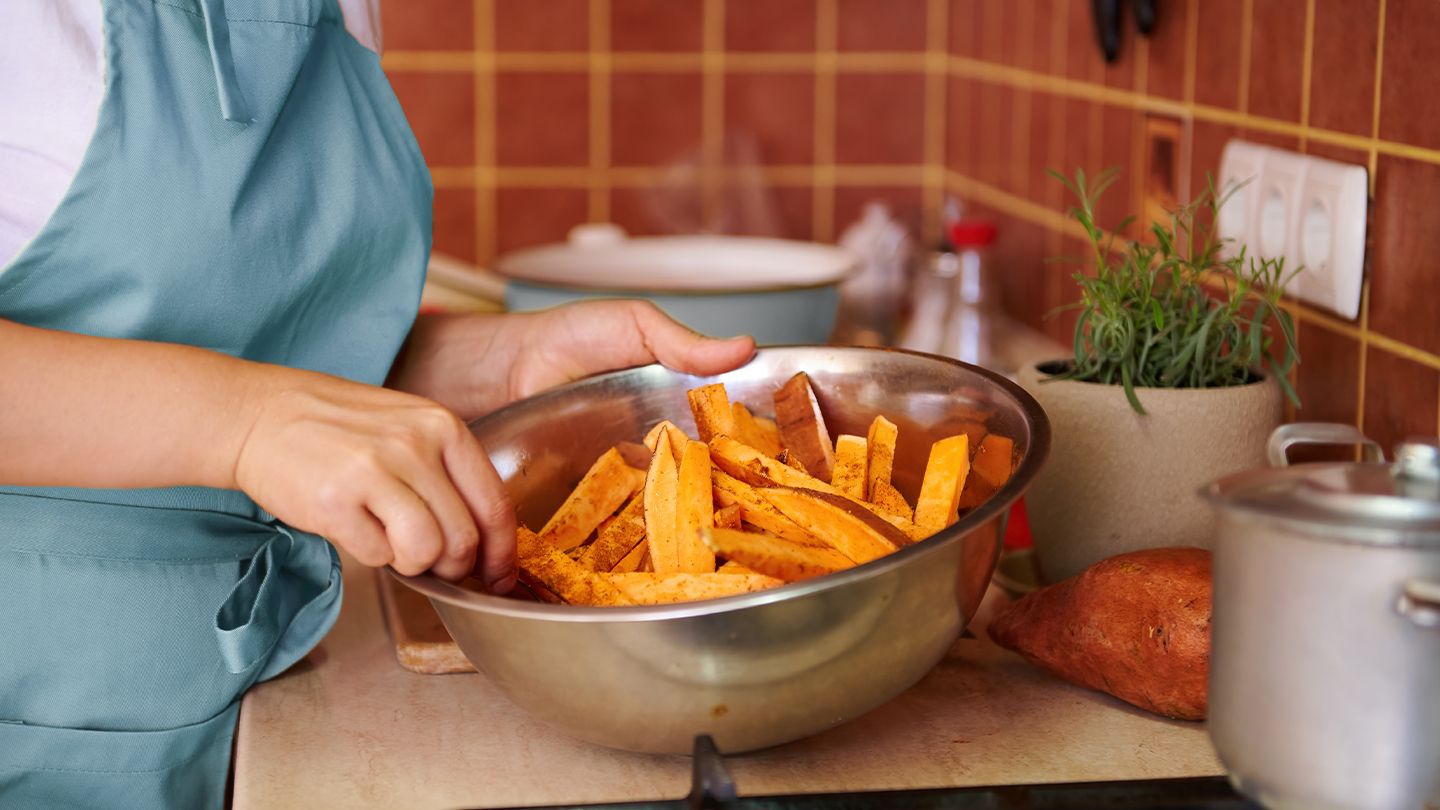Why settle for the same old, same old when it comes to vegetables? Break out of your food rut with the help of sweet potatoes! This root vegetable is the perfect blend of fiber, complex carbohydrates, and vitamins to satisfy your appetite and taste buds alike. But we know what you may be thinking — is there much more to it than just baking it? We think so!
Let us open your eyes to the value of sweet potatoes and show you all the ways you can use them in your everyday recipes. It might just surprise you and become a new pantry staple.
Are Sweet Potatoes Healthy?
Sweet potatoes aren’t just a tasty addition to your meals — they’re also incredibly nutritious. Their vibrant orange color is a visual indicator of their health benefits, as it signifies the presence of beta-carotene, a powerful antioxidant that our bodies convert into vitamin A. But the benefits of sweet potatoes go far beyond that. Here’s what makes sweet potatoes a healthy choice.
Rich in Vitamins and Minerals: Sweet potatoes contain essential vitamins and minerals, including vitamin C, potassium, and vitamin B6. Vitamin C supports your immune system and helps your body absorb iron, while potassium is crucial for heart health and regulating blood pressure. Vitamin B6 plays a role in brain development and function.
High in Fiber: Sweet potatoes are an excellent source of dietary fiber, which is essential for digestive health. Fiber promotes regular bowel movements, prevents constipation, and can contribute to a feeling of fullness, helping with weight management.
Low in Calories: Despite their sweet taste, sweet potatoes are relatively low in calories, making them a great option for those looking to maintain or lose weight. Their natural hint of sweetness satisfies your sweet tooth in a healthier way than sugary snacks do.
Complex Carbohydrates: The complex carbohydrates in sweet potatoes provide a steady energy source, helping stabilize blood sugar levels. This can help prevent energy crashes and keep you feeling energized throughout the day.
Anti-Inflammatory: The compounds found in sweet potatoes have anti-inflammatory properties, which may help reduce the risk of chronic inflammatory conditions such as arthritis and heart disease.
Nutritional Value of Sweet Potatoes
The USDA lists the following nutritional information for one sweet potato about 5 inches long, weighing about 130 grams (about 4.6 ounces). (1)
- Calories 112
- Total Fat 0g
- Sodium 72mg
- Total Carbohydrate 26g
- Dietary Fiber 4g
- Total Sugar 5g
- Protein 2g
- Vitamin A 18,500 IU
- Vitamin C 3mg
- Potassium 438mg
- Vitamin B6 0.27mg
Can You Eat Sweet Potato Skins?
Yes, you can absolutely eat sweet potato skins, and doing so is a good idea. Eating the skin allows you to maximize the nutritional benefits of this vegetable. Plus, the edible skin provides a nice contrast in texture to the soft flesh of the potato. Just be sure to wash the sweet potato thoroughly before preparing to remove any dirt or residue.
15 Creative Sweet Potato Ideas
- Sweet Potato Fries: Cut sweet potatoes into thin strips, season them with your favorite spices, and bake them for a healthier twist on classic French fries. Does your oven have a convection bake? If so, use this setting to help with even baking and crispness.
- Stuffed Sweet Potato: There’s nothing quite like a good ol’ baked sweet potato. Fill it with savory or sweet toppings like black beans and cheese, quinoa and vegetables, or almond butter and cinnamon.
- Sweet Potato Toast: Slice sweet potatoes lengthwise into thin pieces and toast them in a toaster. Top with avocado, peanut butter, or any favorite topping. This makes a great mid-morning snack.
- Sweet Potato Pancakes: Blend or grate sweet potatoes into your pancake batter for a fun flavor boost at breakfast.
- Sweet Potato Chips: Thinly slice sweet potatoes, toss with olive oil and seasoning, then bake in the oven until crispy for a homemade chip alternative.
- Sweet Potato Noodles: Use a spiralizer to turn sweet potatoes into noodles, then cook and serve them with your choice of sauce for a healthy and gluten-free pasta alternative.
- Sweet Potato Tacos: Fill soft tortillas with roasted or mashed sweet potatoes, black beans, salsa, avocado, and other taco fixings.
- Give It a Try: Sweet Potato and Black Bean Tacos
- Sweet Potato Croutons: Say goodbye to boring croutons and use sweet potatoes instead to up the nutrition. Combine roasted diced sweet potatoes with fresh kale, nuts, seeds, and a flavorful vinaigrette for a hearty salad you’ll be making on repeat.
- Sweet Potato and Coconut Soup: Make a creamy and comforting soup by blending cooked sweet potatoes with coconut milk, spices, and herbs.
- Sweet Potato Smoothie: Add cooked and cooled sweet potatoes to your morning smoothie for added creaminess and nutrition.
- Sweet Potato Tater Tots: Shape mashed sweet potatoes into tots, then coat with breadcrumbs, and bake until crispy for a healthier version of tater tots.
- Sweet Potato Curry: Incorporate diced sweet potatoes into your favorite curry recipe for a sweet and spicy take.
- Sweet Potato Muffins: Bake sweet potato muffins using sweet potato puree in the batter. These muffins can be a convenient grab-and-go breakfast option. They’re kid-friendly, too.
- Sweet Potato Chili: This cozy dish gets even more delicious when sweet potatoes are added to the mix. The flavor melds perfectly with tomato and cumin, creating a truly satisfying meal.
- Give It a Try: Sweet Potato Chili
- Sweet Potato Hummus: This delectable dip takes traditional hummus to new heights by infusing it with the natural sweetness and earthy notes of roasted sweet potatoes. The result is a creamy, vibrant orange spread that’s as visually appealing as it is delicious.
These fun ways to eat sweet potatoes are really just the beginning. As you become more at ease in the kitchen, you’ll realize that these vegetables can be versatile additions to nearly any dish, infusing excitement into your daily meals. This variety is key to keeping you motivated and fulfilled on your healthy eating journey.
Editorial Sources and Fact Checking
- FoodData Central. United States Department of Agriculture.

